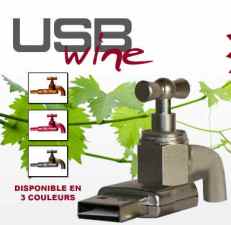Thank you for coming to this Blog. It is moving to a different address:
See you there!
Thank you for coming to this Blog. It is moving to a different address:
See you there!


Carlsberg seem to be specializing in alternative marketing. Last August, they littered the streets of London with £5,000 worth of £10 and £20 banknotes with a sticker on them saying “Carlsberg don’t do litter. But if they did it would probably be the best litter in the world“. Click here to check it out!
The other day, I received a “Gift” from a Facebook pal: it was a picture of a bottle of Carlsberg. Of course, it was posted to my Funwall, and everyone found it great fun and the bottle certainly started circulating at hyper-speed round the Facebook-world.
Clever!…sounds like beer makes you smarter!
 Just found this on the web: USB Wine
Just found this on the web: USB Wine
USB Wine, download wine straight from the vineyards !
Uploaded by zs2creative
The concept is brilliant, not sure it will work on my laptop because of the limited volume, but I might still be able to download half bottles. I wonder whether this concept could be applied to other products such as paint, toner, maybe even diesel oil or gas?
Try it, you’ll like it, sorry the video is in French, but then, who else could have designed a USB Wine tap! in fact, the story behind the video is real: if you ask to test a download, you will be taken to the Web site of n Internet Wine Boutique…
Smart eh…!
 For many years (ever since I saw the film E.T.) I have believed that distance makes people more aware of what is going on back “home”.
For many years (ever since I saw the film E.T.) I have believed that distance makes people more aware of what is going on back “home”.
As a Reseller (some say Partner), when you are exposed to the daily difficulties and dangers of life in the “Field”, trying to sell the right solution to your customer, you quickly become painfully aware of what your favorite Vendors should be doing to make you want to sell more of their products.
The frustrating part is that although you have often spent time and energy explaining these simple things to the Vendor’s Channel management team, you are either faced with empathy (and therefore frustration because your contacts cannot help you due to the bureaucratic nature of today’s global channel programmes) or a clear lack of understanding of what seems so simple to you.
As Channel Consultants, we then get hired to tell our Clients what they have already been told by their Partners:
Do you get the picture? Abraham Maslow, a famous motivational theorist once commented: “If the only tool you have is a hammer, you will see every problem as a nail.” We’ve all heard that one before…
So where did I get this E.T. thing from? Very simple: Vendor’s “Partners” often feel like E.T.: they feel they have been abandoned out in the field, they have been trying to phone home but just can’t get through to someone who will hear them out.
These days, any FMCG Marketing company is capable of sending a personalized direct mail piece to each one of 25,000 households in a database but our Channel Marketing organizations still seem to be trying to cram square channel pegs into round channel program holes, relentlessly applying Henry Ford’s famous “…you can have the Ford T in any color as long as its black…”
Instead of using the phenomenal power and flexibility provided by the hardware and software designed by our own industry, we are regressing, taking people out of the field to reduce costs, thus eliminating the only flexible stage of our relationship with our Channel Partners.
So is everybody doing it wrong? Thankfully not, but when you start probing your partners about who does it right, the same names always come up. And what they are doing is pretty basic: the empower the people who listen to what the Channel wants and they design sufficiently flexible programs and processes to delight more Channel Partners who can pick and choose what they like.
Easy!
 In the last three years, I have probably rented 40 cars per year from Hertz and therefore belong to the Gold “President’s Circle” (it did make a difference when I got called by one of their their European Customer Services Team Leaders).
In the last three years, I have probably rented 40 cars per year from Hertz and therefore belong to the Gold “President’s Circle” (it did make a difference when I got called by one of their their European Customer Services Team Leaders).
A few months ago, upon returning a rental car, I was blamed by the Hertz employee for having tried to hide damage to the front bumper by painting it over with a blue (remember this colour, it comes back later) felt pen. I was allowed nastly looks, cynical mumblings and was absolutely outraged since not only would I never have envisaged doing something like that but I also had no responsibility in the said damage. I got stung for 148.15 Pounds Sterling to repair and repaint a scratch I had absolutely nothing to do with.
This week like many others, I picked up a car from Hertz at an airport station. I got the keys, was told the car had been checked and had no damage and scrambled to where it was parked. The globally-warmed Euro-tropical rain was pouring as usual and I tried to inspect the car for scratches but how do you see anything on a black car when it is raining!
After driving 180 miles I parked the car (still raining) and checked into my hotel. The morning weather was no better and I drove to my appointment. Somehow, the sun came out during the morning and when I got back to the car at 2.00 PM, I noticed what looked like a smudge above one of the headlights. It was tacky and seemed to partly cover some very fine scratches (did somebody use a ScotchBrite on the coachwork?). I immediately called the Hertz station to report the problem and was given the “Party Line”: “Sir, you have until 12 noon to report damage…it is now 2pm, you are too late, I cannot record this damage; you will have to work it out when you return the car”. I explained the whole weather story but it simply felt like hitting a brick wall. The lady finally asked me whether I actually wanted to report something and although I told her I thought Hertz might then use that information to blame me, I did report the scratch
When I returned the car, the guy asked me a lot of questions: was it a long term rental, did I have a SatNav, etc…I realised afterwards that this was because he had a note on his handheld terminal but didn’t know what the note was about. He checked the car, didn’t see the smear and scratches and asked me to go to the station to get my receipt. At the counter, I was told that there was a note that I had reported a scratch but that since the car had just been checked it seemed OK.
That car was made available to me with an unreported scratch and has probably already been rented again by a new unsuspecting customer who is at risk of being blamed for something he has nothing to do with. Ultimately, some poor guy will get caught and will pay for the repairs. Hertz won’t…now to my point about weak processes and policies:
At Heathrow, Hertz’s main competitor (they try harder) has a floodlit and sheltered area at the car park exit, where a person inspects the car with you, signs the manifest with you and only then opens the barrier. There can be no argument. I suggested this in my first letter but probably wasted the ink, paper and stamp.
Another suggestion I made was to impact the employees when a customer reports damage they missed. There could be a bonus for the guy who never misses a dent or a scratch.
But that would be too simple, it would mean they couldn’t blame the customer and get him to pay for the repair. How many times do you think it will take someone before they move to the people who try harder?
Great Customer Service is the ONLY differentiator when you are in the services business. That means you should at least try not to question the good faith of your most loyal customers. They are your evangelists, your influencers…don’t screw with them, or they’ll vote with their feet and tell the world about it.
19th July 2007:
 Well…a few days ago, Hertz Europe contacted me because they had seen this Blog. I had a very constructive conversation with the lady who called me and I explained that I didn’t hate Hertz (I really do find they generally offer great service at a good price) but since my day job is about enhancing customer experience and relationships through better processes, it was evident to me that there was definitely something rotten in the Kingdom of Hertz (by the way, Hertz means Heart in German and I felt rather like Alice in Wonderland saying the roses weren’t red-or was it blue– when they were being painted to please the Queen of
Well…a few days ago, Hertz Europe contacted me because they had seen this Blog. I had a very constructive conversation with the lady who called me and I explained that I didn’t hate Hertz (I really do find they generally offer great service at a good price) but since my day job is about enhancing customer experience and relationships through better processes, it was evident to me that there was definitely something rotten in the Kingdom of Hertz (by the way, Hertz means Heart in German and I felt rather like Alice in Wonderland saying the roses weren’t red-or was it blue– when they were being painted to please the Queen of Hertz…sorry…Hearts!!!).
To cut a long story short, I provided the lady with as much information as I could and we found that the situation was even more complex than I had assumed. She called me today to say that she had requested a refund and apologized profusely for the way things had been handled.
 I promised I would amend the above post to reflect the full story and wished her good luck in improving what is (was?) clearly a weak link in Hertz’s generally outstanding organisation.
I promised I would amend the above post to reflect the full story and wished her good luck in improving what is (was?) clearly a weak link in Hertz’s generally outstanding organisation.
I can only say that I am impatient to see the changes Hertz will make to the whole damage assessment process and I know they will find that whatever investments they make will result in a strongly improved customer experience and more profitable business.
Janice, Hertz Europe can thank you for handling this situation extremely well. Lets both hope that your findings result in the necessary improvements.
In an indirect channel model, Influencer Marketing is hard work. The main problem for Vendors selling through an indirect channel is that they are not actually in any form of business contact with the Influencer. It could be a Consultancy or a System Integrator, but they are not reselling the Vendor’s products, they are not either necessarily in a business relationship with the Reseller or the Distributor.
So how do you reward an influencer for convincing their client to buy a particular Brand? The only way is to write him a cheque and that is where things get difficult. What audit trail do you have? The Influencer says he convinced the customer to buy your stuff, the Reseller invoiced and installed it, the Distributor bought it from the Vendor and shipped it to the Reseller. You now need to convince your Finance department to write a cheque…not easy.
In a direct sales model, companies like Dell actually invoice the End User that was “influenced”. They therefore have direct visibility of the whole business process and can therefore pay a commission to the Influencer who reported the opportunity.
In the Pharmaceutical industry, the influencer is the Doctor (GP) who prescribes one medecine rather than another. And in certain countries, the Pharmaceutical companies monitor the sales of their branded molecules via the pharmacies situated in the vicinity of a medical practice. This gives them a view of which GP is doing a good job at promoting and prescribing their products. They might then invite the most influencial GPs on a study tour of -say- the Seychelles.
In the IT business, Vendors go to a lot of trouble to influence the Influencers. Its tough, but if you crack it, it really does pay off.
This morning, while working on a Best Practice research I am doing for a major ICT company, I interviewed a Country Marketing Manager who told me the EMEA organization were ROI control freaks.
They approve and hand out marketing budgets at the beginning of the year and then throughout the year, they demand that the local managers complete ultra detailed plans and questionnaire in order to approve every action they are trying to implement with their partners.
Well guess what: when we speak top the channel partners of that Vendor, they tell us they can’t understand why the competition’s channel managers seem to have the authority to discuss, design and authorize a joint marketing activity while this Vendor’s people sometimes take months to get the approval.
In the late 19th century, John Wanamaker, the successful Philadelphia retail entrepreneur famously said “I know that half of my advertising is wasted. I just don’t know which half“. What he meant was that you have to live with that lack of real control. I you try and get scientific…guess what…you’ll kill the half that was actually working.
Marketing is about being bold and confident and somewhat analytic. Finance have to trust our ability to design programs, tools and messages that are going to grow market share, mind share and awareness. ROI is making a lot of money for the companies that say they can help calculate and control it…just google “Marketing ROI” and see for yourself.
 Have you noticed how the concept of “Channel” is evolving?
Have you noticed how the concept of “Channel” is evolving?
A few years ago, the Channel Partner was the-guy-who-actually-got-your-box-to-the-End-User: Distributors, Aggregators, Importers, Resellers, Retailers, etc..It didn’t matter if you produced Hardware or Software, you still had to get a box to your customer. On the other hand, the Channel wasn’t that involved in Services (or just a little).
Application software came as a dozen diskettes (remember the diskette, 8″, 51/4″, 31/2″, POP!) that might contain up to 900 kilobytes each of data (remember the kilobyte?). You would invariably spend half your evening stuffing diskettes into the computer when it asked for more.
Suddenly, the Internet came of age and with it, e-Everything: e-Tailers, e-Commerce, e-Business have now acquired a significant share of the day to day business and with that change, the way we do business has fundamentally changed. When we talk of the IT Channel today, we have to include a whole spectrum of new players. We now dowload 200Mb applications via ADSL connections and pay the license with the company credit card.
Enter the Influencer family: Consultants and System Integrators, Web Integrators, Telecom Resellers, Network Integrators, ISVs, Specialized and Managed Services Companies, are now considered part of the “Channel” (although they rarely deliver a box to an End User).
As a result of this new granularity, designing a good Channel Program has become increasingly complex and now requires us to go well beyond the “Buy one-get one free” (Push) or “Sell loads and get a rebate” (Pull) concepts that seemed to work before. Instead of that, we now have to design Influencer Programs and guess what…when you ship you product through a traditional channel, it’s really tough to convince your CFO you need to pay a guy who says he actually created the opportunity for you! It’s not a rebate or a discount: if he didn’t buy anything from you, it must be a bribe!
But that’s another story and one of these days, we’ll talk about why Dell is still best placed to influence the Influencers.
 Whenever I visit a distributor, I always make sure I pay a visit to the warehouse manager and invite him to show me anything he believes we could improve. If possible, I would ask one of our logistics managers to come with me, provided they can share the same language. Try it if you have never done it before. You will discover the impact of the cost savings policies your company implements without necessarily realizing that the cost is actually only being transfered elsewhere.
Whenever I visit a distributor, I always make sure I pay a visit to the warehouse manager and invite him to show me anything he believes we could improve. If possible, I would ask one of our logistics managers to come with me, provided they can share the same language. Try it if you have never done it before. You will discover the impact of the cost savings policies your company implements without necessarily realizing that the cost is actually only being transfered elsewhere.
Distributors quite rightly represent themselves as a bank and a conveyor belt between the Vendor and the Channel Partner; a direct extension of the Vendor, so when we change the way we package or ship something, we should remember that our logistical extension is going to have to cope with it. They also need to operate efficiently so we should always make sure that our decisions aren’t at the cost of our Channel and that we are always doing what is best for them. Here are just two real life examples:
 Finding the colors. I was once told by an angry warehouse manager that they had to open every carton of 8 toner cartridges they received -and they received pallet loads of them every week- each box taken out for the staff to know which color they were to receive in their system.
Finding the colors. I was once told by an angry warehouse manager that they had to open every carton of 8 toner cartridges they received -and they received pallet loads of them every week- each box taken out for the staff to know which color they were to receive in their system.
As a result of the strong relationship we built with the logistics teams of our Partners, our Brand became synonymous of ease to do business with. This invariably got back to the senior management of the distributor who would then use their influence to increase their sales of our products. It became a real win-win situation, reducing both our and their cost of doing business.
…and you don’t know what you don’t know!
“Education is a progressive discovery of our own ignorance” Will Durant (1885-1981)
Five years ago, I was with a European executive of one of the largest global IT Vendors brainstorming what has since become a highly successful (and ongoing) channel ecosystem building program. The guy was extremely astute and aware and this six hour face to face session allowed us to lay down a very solid foundation for the program (it also resulted in me falling asleep in the taxi during the short drive back to Heathrow).
His opening gambit was the “You know…” saying and I regularly find I need to remind Vendors of such a basic concept. Think of it: we deliver our products to our end user customers through several layers of channel partners who are in fact serving their own respective customers. This is particularly true in the SMB and Mid-Market segments. We always tend to forget that end users are purchasing many different brands from “our” partners. All we see is the business the partner generates for us. That is what we know.
What we don’t know -unless we deliberately go and research it- is how big that channel partner actually is, and how important he is for his customer (be that a reseller or an end user). A simple illustration could be that if we own 20% market share in an market that represents 20% of the ICT market, we probably represent no more than 4% of a distributor’s activity and a varying share of his margin and profit. Of course, things are not as simple but we must never forget that our basic channel mind-share is no more than the share we represent in a partner’s total business.
One can increase that mind-share in two ways: increase our share of his business or become a more profitable product line for him through exciting channel programs or by reducing his costs of doing business with us.
We should always ask ourselves whether our Account Managers actually understand that their channel partner is more interested in how he makes money and satisfies his customers with our products than what products he is actually selling…
I suppose one could call that being somewhat modest. If we don’t know what how our Partner perceives us, we are probably going to be seen as arrogant in our relationship.